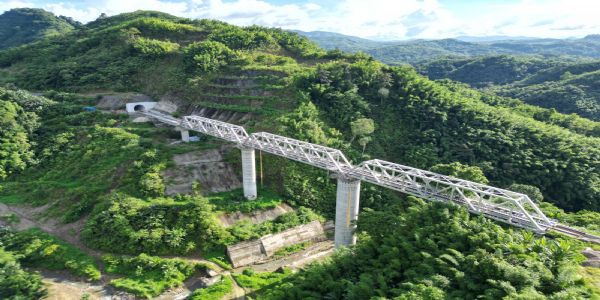
Prayagraj, 30 Aug (HS): Throughout decades,
Mizoram is considered one of the most beautiful yet remote states in India-
green hills sweeping into the misty air, miles of bamboo forests, and cultural
communities that have been geographically isolated. Hitherto, the state of
Mizoram, the capital of which is called Aizawl, took five hours to be reached
via a road network of narrow highways that destroyed every time there was a
monsoon. A 51.38-km-long engineering wonder, the BairabiSairang railway line
has cost a little over 8000 crores to transform this fact.
The 45-tunnel 153-bridge line, which
features the second tallest pier bridge in the country, 114 meters (taller than
the Qutub Minar) now links Mizoram to the national railway grid. This project,
which is more of a construction success, is already transforming the economy of
Mizoram, its society, and strategic value.
A Lifeline of Connectivity: The railway
cuts reduce the road distance of seven hours between Aizawl and Silchar into
mere 3 hours of the train thus making movement much faster, safe, and
economical. Passenger trains can now serve at speeds of up to 100 kmph and so
residents are now able to access healthcare centers, universities and
commercial centers with a great deal of reliability.
That is not just convenience. It is
estimated that the regional GDP growth could be enhanced by 2-3 percent each
year due to better connectivity as more people can travel without travel
barriers and more people have access to the economy. To a small state such as
that of Mizoram, where the Gross State Domestic Product (GSDP) is about ₹25,000
crore, a 2 percent increase would translate into an extra 500 crore revenue
into the economy every year.
Economic Growth and Prosperity: The most
observable change is economic. The railway has made it easier to access the
Indian wider markets by transporting the agricultural produce of Mizoram
(bamboo, chillies, oranges, ginger, and pineapple) at a drastically reduced
cost. Currently, post-harvest losses due to poor transport in the Northeast
average around 25–30%. Through rail connectivity, it is projected that the
level of spoilage will reduce to half and this will increase the incomes of
farmers directly.
There is also local entrepreneurs to
benefit. The costs of logistics that used to cost 15-20 per kg by road should
come down by 30-40 percent through rail. The savings are spread to other areas:
vital commodities like fuel, cement and daily grocers are estimated to fall by
10-20 percent, making life in the state more affordable to more than 1.2
million of Mizoram people.
Another multiplier is job creation. The
project created thousands of construction and engineering employment during the
course of construction. In the future, economists estimate 3,000-5,000 of the
indirect jobs each year in the logistics, hospitality, retail and tourism
associated with the railway. This would bring the unemployment level in
Mizoram, which is already high than that of the country, closer to equilibrium.
Tourism and Trade as Growth Engines: Mizoram
has been a long unrecognized tourism gem. Its untouched hills, traditional
festivals and eco-tourism potential was limited by inaccessible location. Rail
accessibility means that the government estimates that tourist arrivals would
increase by 40-50 percent within the next five years, an influx that would
drive up sales in hotels, homestays, handicraft markets and transport services.
Trade, too, is poised for a leap. The railway connects Mizoram to the rest of
India and places it near Myanmar’s Sittwe Port, thus placing the state into
international supply networks as part of the Act East Policy of India. Planned
extensions Mizoram may become a transit hub with a value of between 10-12
billion dollars in trade between India and Southeast Asia in the next ten
years.
Social Integration and Inclusion: The
railway has strong social overtones to do with more than economics. In the
past, the isolation of Mizoram gave rise to a feeling of physical and
psychological detachment to the mainstream of India. That gap is now bridged
symbolically and practically by rail connectivity, which makes national
cohesion stronger.
Improved transport also implies improved
governance delivery. There is easy access of teachers to schools located far,
faster transportation of doctors and medicines and more access of government
officials to the communities previously considered remote. Relief supplies can
now also be transported by train in case of a disaster with the risk of lives
being saved in the event of floods and landslides which are common in the area.
Sustainability and Resilience: There was
a tremendous technical and human cost to building the line through the steep
hills of Mizoram. Landslides, challenging geology, and a tragic bridge collapse
that killed 26 workers in 2023, which occurred with the project, were common.
Nevertheless, the construction of the line was done with an eco-sensitive
approach in mind-long tunnels and elevated viaducts minimize on-site
deforestation and destruction of habitats. The railway establishes a new
people-centered infrastructure by engaging the locals and reducing
displacement. It shows how development can be done at levels of ecological
sustainability despite fragile landscapes.
The Numbers That Tell the story: The
BairabiSairang line of rail might not be much more than 51.38 kilometers, but
in those 51.38 kilometers there is a tale of change. Five of these stations,
four of them brand new at Hortoki, Kawnpui, Mualkhang, and Sairang, now make
Mizoram squarely on the Indian railroad map. Engineers constructed an
impressive 153 bridges, including India’s second tallest pier bridge at 114
meters above the valley, higher than the Qutub Minar, and excavated 45 tunnels
along with a 12.8 kilometers-long path through some of the most stubborn rock
to cut this route. Even the budget of this grandiose project increased to
almost 8,000 crore as compared to its original budget of 5,020 crore, but the
fruits of this project would be even bigger. Economists estimate that it will
increase Mizoram Gross State Domestic Product at an annual rate of 500-700
crores which is impressive considering that the state is only 1.2 million. Poor
access has long been a limiting factor in tourism and this is projected to
increase by 40-50 percent in the coming five years making the hills and
festivals of Mizoram accessible to the rest of the world. This will also bring
a difference to everyday life, with freight, and necessities (fuels, food, etc)
becoming cheaper, the living cost will go down by 10-20 percent. Behind all the
bridges, all the tunnels, all the meters of railroad track are not only steel
and stone, but also the assurance of a better future and a new identity of
Mizoram.
From Isolation to Integration: The
BairabiSairang railway is not an ordinary series of steel tracks over the hills
of Mizoram; it is a metaphor of change. It is rewriting the socio-economic fate
of the state by cutting down time of travelling, cutting down costs, improving
agriculture, promoting tourism and linking Mizoram to international markets.
To the 1.2 million people of Mizoram,
these trains carry with them a lot more than passengers and freight they carry
prosperity, inclusion, and opportunity. To India, the line is a major victory
that made a formerly distant frontier into a bridge to Southeast Asia.
There is more in the rhythm of the
trains now resounding in the valleys of Mizoram, that development may be
inclusive and sustainable and even extensive, and may convert the margins into
developmental centers.
Hindusthan Samachar / Abhishek Awasthi








